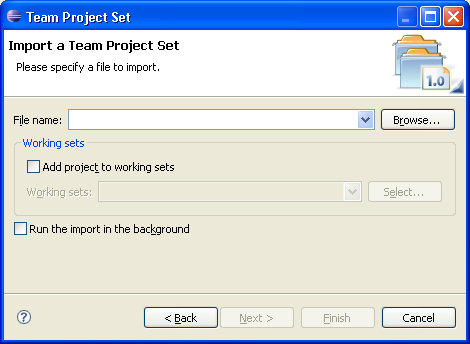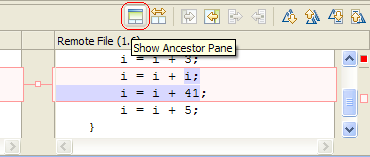The following tips and tricks give some helpful ideas for increasing your productivity. They are divided into the
following sections:
| Find Actions can open files from file system |
The Find Actions command, usually accessible with Ctrl+3, now allows to open
a file if the query is the path of an existing file on the filesystem.
|
| Process ID in Debugger |
Eclipse Debug framework can now show process ID (pid) of the started processes.
The pid is shown (if supported by the concrete debugger implementation) in the Console
view description and Properties page for the process.
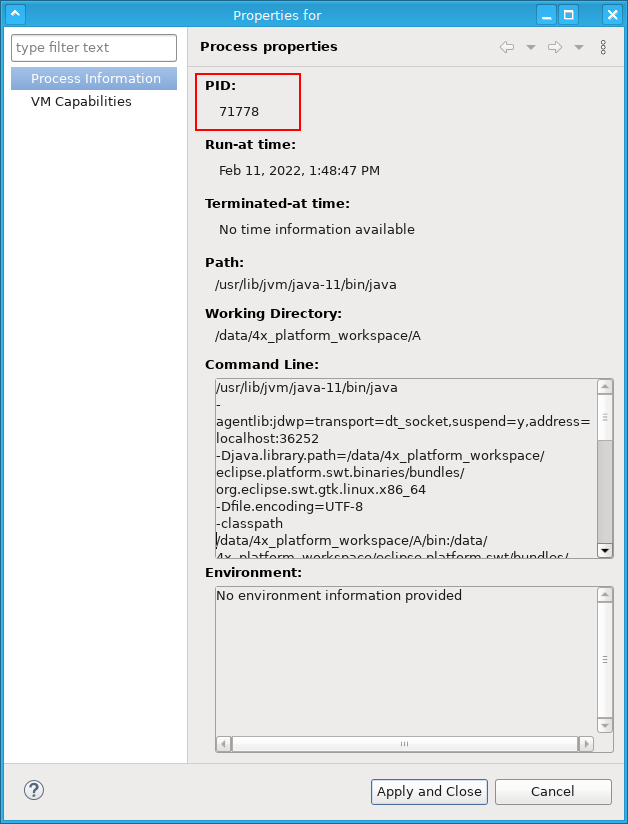
This should work out of the box for all
processes using or extending org.eclipse.debug.core.model.RuntimeProcess, and can be
easily added to other processes by specifying IProcess.ATTR_PROCESS_ID process attribute.
Additionally, the Java debugger now shows process id for the process element in the Debug view.
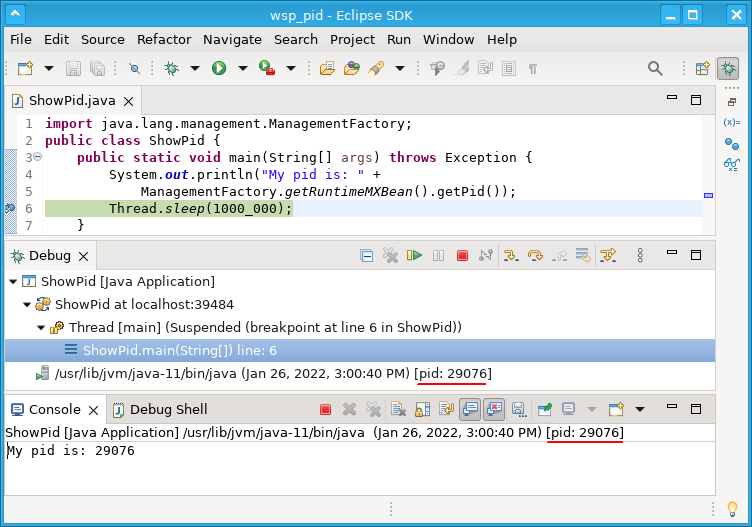
|
| Using the dark theme |
You can use Eclipse with the default dark theme. You can select the dark theme on the
 General >
Appearance preferences page. General >
Appearance preferences page.
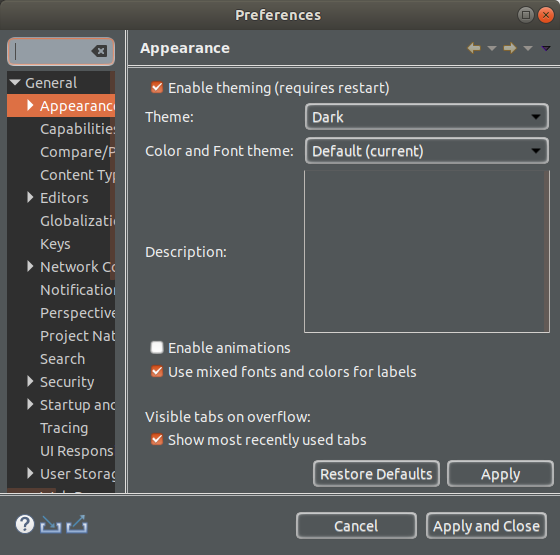
After a theme switch it is recommended to restart Eclipse via File > Restart
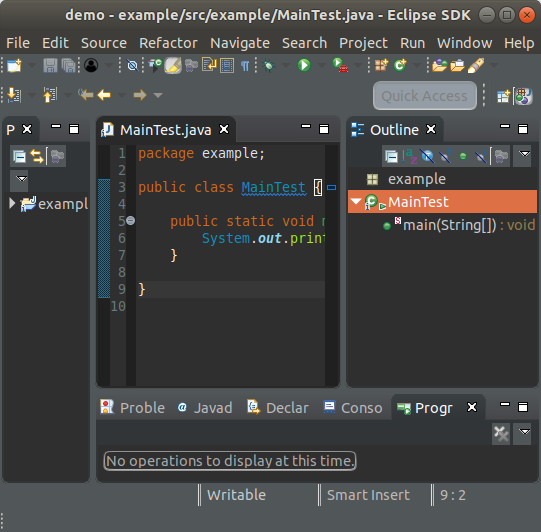
|
| Now, where was I? |
Workbench editors keep a navigation history. If you open a second
editor while you're editing, you can press Navigate > Backward (Alt+Left Arrow, or the
 back arrow on the workbench toolbar) to go
back to the last editor. This makes working with several open editors a whole lot easier. back arrow on the workbench toolbar) to go
back to the last editor. This makes working with several open editors a whole lot easier. |
| Find Actions |
You can quickly find all manner of user interface elements with the Find Actions search button at the
top of the workbench window. Click the button or use the Ctrl+3 binding to switch focus to it. Matching
elements include (but are not limited to) open editors, available perspectives, views, preferences, wizards,
commands, and launch configurations. Simply start typing the name of the item you wish to invoke and we will
attempt to find something in the Workbench that matches the provided string.
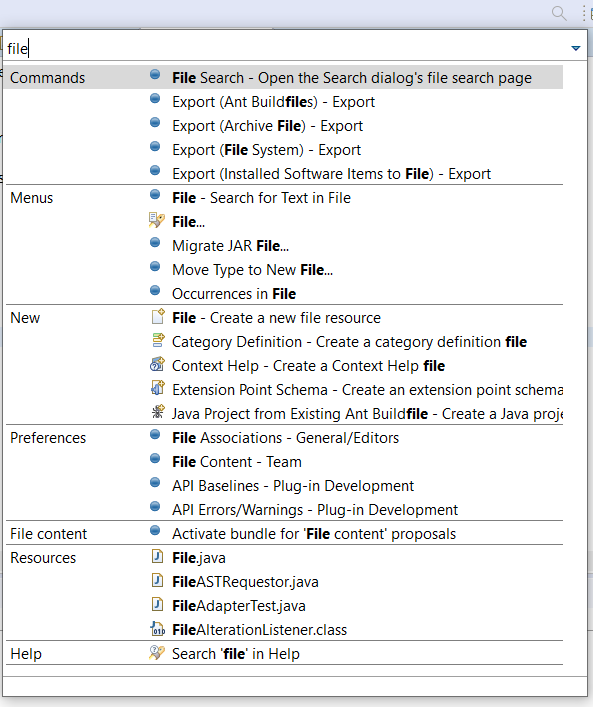
|
| Full Screen mode |
You can toggle the Eclipse full screen mode via shortcut
(Alt+F11) or menu (Window > Appearance > Toggle Full Screen). |
| Ctrl+E editor list |
You can quickly switch editors using the Ctrl+E keybinding which
opens a list of all open editors. The list supports type-ahead to find the editor as well as allows you to close
editors using a popup menu or the Delete key. |
| Like to start afresh each session? |
A setting on the
 General >
Editors preference page closes all open editors automatically whenever you exit. This makes start-up
cleaner and a bit faster. General >
Editors preference page closes all open editors automatically whenever you exit. This makes start-up
cleaner and a bit faster. |
| Automatic Save of dirty editors |
You can configure the automatic save of dirty editors in Eclipse via the
General > Editors > Autosave preference page which allows you to enable/disable the autosave
and change the interval of autosave.

|
| Prevent in-place OLE editors |
By default, on Windows, OLE applications like Microsoft Word or Excel
open as in-place editors inside of Eclipse. You can force OLE applications to open as stand-alone applications by
unchecking the "Allow in-place system editors" option on the
 General >
Editors preference page. General >
Editors preference page. |
| Opening editors using drag and drop |
You can open an editor on an item by dragging the item from a view like
the Project Explorer or Package Explorer and dropping it over the editor area. |
| Tiling the editor work area |
You can use drag and drop to modify the layout of your editor work area. Grab an editor or view tab and drag it
to the edge of the editor work area. The green drop rectangles indicate which way the editor work area will
split.
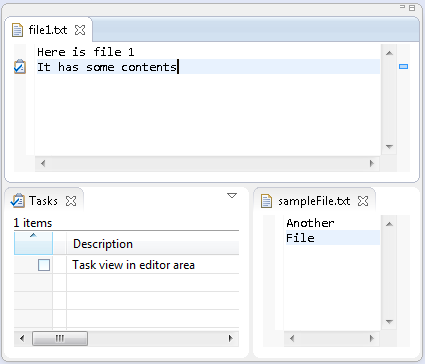
|
| Splitting an editor |
To view or edit multiple sections of an editor at once, you can split / unsplit the currently active editor
via:
- Window > Editor > Toggle Split Editor (Horizontal)
- Window > Editor > Toggle Split Editor (Vertical)
Or just use one of the key bindings:
- Ctrl+_ to split horizontally
- Ctrl+{ to split vertically
You can also open a second editor instance via Window > Editor > Clone.
|
| Open editors with a single click |
Use the Open mode setting on the
 General
preference page to activate single click opening for editors. In single click mode, a single click on a file in
the Project Explorer view (and similar views) selects and immediately opens it. General
preference page to activate single click opening for editors. In single click mode, a single click on a file in
the Project Explorer view (and similar views) selects and immediately opens it. |
| Collapsing all open items |
Use the Collapse All button on the toolbar of the Project Explorer view (and similar views) to collapse
all expanded project and folder items.

|
| Global find/replace |
Use  Search > File from
the main menu to specify the text that you want to replace and the scope in which you want to replace it. Then
press Replace.... Search > File from
the main menu to specify the text that you want to replace and the scope in which you want to replace it. Then
press Replace.... |
| Replace from Search view |
You can replace the matches in the files by using Replace... or
Replace Selected... from the context menu in the Search view. |
| Show In System Explorer |
If you select a resource and right click, there is a Show In > System Explorer context menu entry
that will open the folder containing that resource in your system's file explorer.
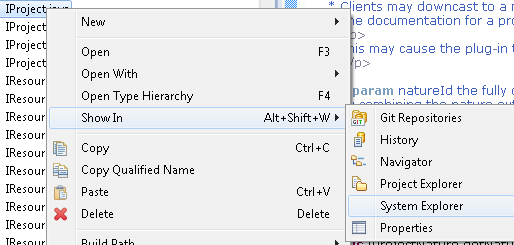
The command
for launching the system explorer can be configured on the
 General >
Workspace preference page. General >
Workspace preference page.
|
| Linking view to current open editor |
The resource Project Explorer view (and similar views) is not tightly linked to the currently open editor by
default. This means that closing or switching editors does not change the selection in the Project Explorer
view. Toggling the Link with Editor button in the Project Explorer view toolbar ties the view to always
show the current file being edited.

|
| Manual editor / view synchronization |
The Navigate > Show In command provides a uniform way to navigate from an open editor to a view
showing the corresponding file (e.g., in the Project Explorer view), or from a file selected in one view to the
same file in a different view (e.g., from the resource Project Explorer view to the Package Explorer view).
Typing Alt+Shift+W opens a shortcut menu with the available view targets.
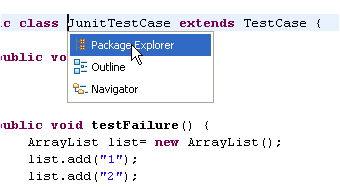
|
| Quick navigation between views, editors and perspectives |
A look at the Window > Navigation menu reveals a number of ways to quickly navigate between the
various views, editors, perspectives, and menus in the workbench. These commands have keyword accelerators such
as Ctrl+F6 for switching between editors, Ctrl+F7 for switching between views, Ctrl+F8 for
switching between perspectives, and F12 for activating the editor.
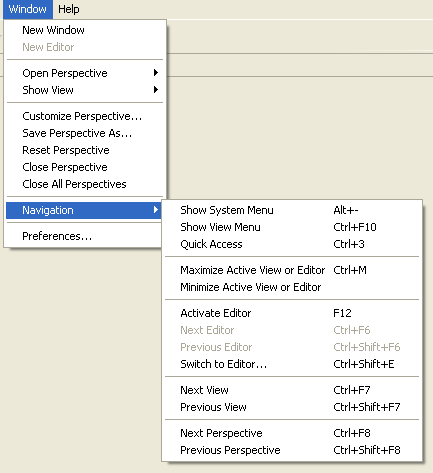
To directly navigate to a particular view you can define a keyboard shortcut to a view via the
 General >
Keys preference page. General >
Keys preference page.
|
| Switch editors and multi-page editors |
You can use Ctrl+PageDown and Ctrl+PageUp to activate
the next or previous editor tab, even in multi-page editors. To switch between pages of a multi-page editor, use
Alt+PageDown and Alt+PageUp. |
| Pinning editors |
When the Close editors automatically preference is active (found on the
 General >
Editors preference page), you can stop an editor from being closed by using the Pin Editor
button which appears in the workbench toolbar. General >
Editors preference page), you can stop an editor from being closed by using the Pin Editor
button which appears in the workbench toolbar.

|
| Square versus round tabs |
Square tabs are used by default in the IDE:

In order to switch back to using round tabs, you can use the preference option Use round tabs on the
 General > Appearance
preferences page. General > Appearance
preferences page.
|
| Reordering editor tabs |
You can rearrange the order of open editors by using drag and drop.
Grab the editor tab and drag it to the position you want the editor to appear. When positioning editors, the
stack icon  indicates a valid spot to
drop. indicates a valid spot to
drop. |
| Middle mouse button closes tabs |
You can click on a view or editor tab with your middle mouse button to
close it. If you do not have a middle mouse button, try clicking on the scroll wheel if you have one. |
| Close Tabs to the Left/Right |
The context menu of editor and view tabs offers Close Tabs to the
Left and Close Tabs to the Right menu to close the corresponding tabs. |
| Minimizing views and editors |
Running out of space? Try minimizing your unused views to reclaim screen real-estate. Each view stack contains
a minimize icon along side the maximize icon.

|
| Maximizing views and editors |
You can maximize a view or editor by double-clicking on the view's
title bar or the editor's tab. Double-click again to restore it to its usual size. |
| Detached views and editors |
It's possible to detach a view or editor so that it can be placed wherever desired, including over another
Eclipse window.
Simply drag the view by its tab to a location outside the workbench window to detach it. You can also drag
and drop other views into the same window.
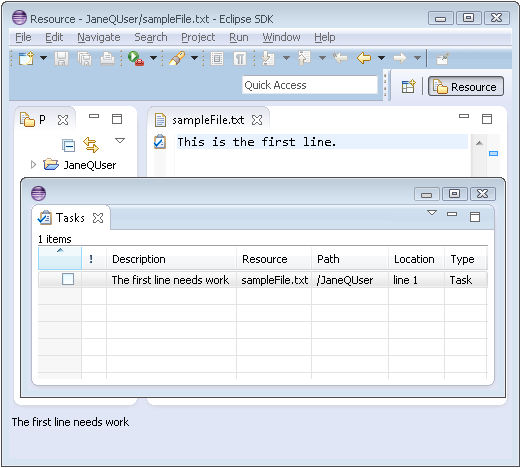
To return the view to the workbench window, simply drag the view by its tab back into the workbench
window.
|
| Restoring a perspective's layout |
Rearranging and closing the views in a perspective can sometimes render
it unrecognizable and hard to work with. To return it to a familiar state, use Reset Perspective on the
 Window > Perspective
preference page. Window > Perspective
preference page. |
User customizable
key bindings |
If you find yourself repeatedly doing some command, you might be able to streamline things by assigning a key
sequence to trigger that command. Assigning new key bindings, and viewing existing bindings, is done from the
 General >
Keys preference page. General >
Keys preference page.
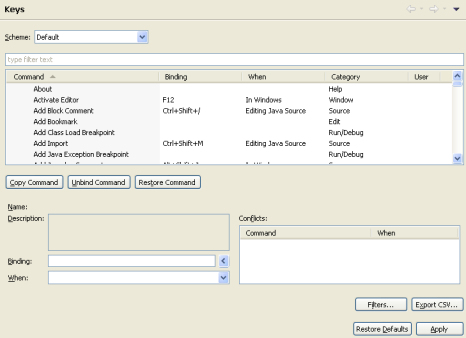
|
| View all keyboard shortcuts |
While working with your favorite editors and views in Eclipse, just press Ctrl+Shift+L to see a full
list of the currently available key bindings. This is a great way to learn what is available in the UI and to
speed up your productivity by learning more key bindings. This information is also available in the improved
 General >
Keys preference page. General >
Keys preference page.
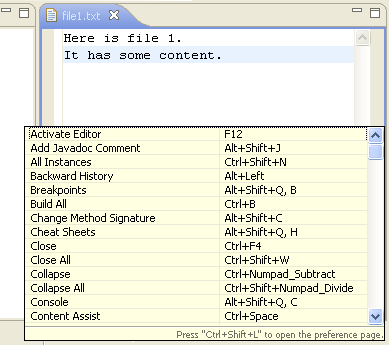
|
| Key binding assistance |
Eclipse supports key bindings that contain more than one key stroke. Examples of such key bindings are
Ctrl+X S (Save in the Emacs key configuration) or Alt+Shift+Q Y (Show View (View:
Synchronize) in the Default key configuration). It is hard to learn these keys, and it can also be hard to
remember them if you don't use them very often. If you initiate such a key sequence and wait a second, a little
pop-up showing you the possible completions will appear.
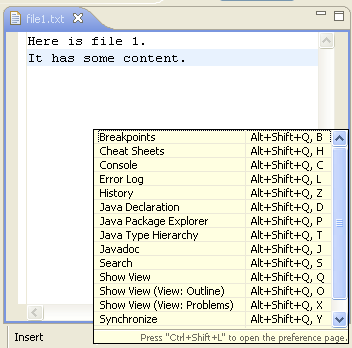
|
| Customizing toolbar and menu bar |
You can customize which items appear on the main toolbar and menu bar using the  Window > Perspective >
Customize Perspective command. Window > Perspective >
Customize Perspective command.
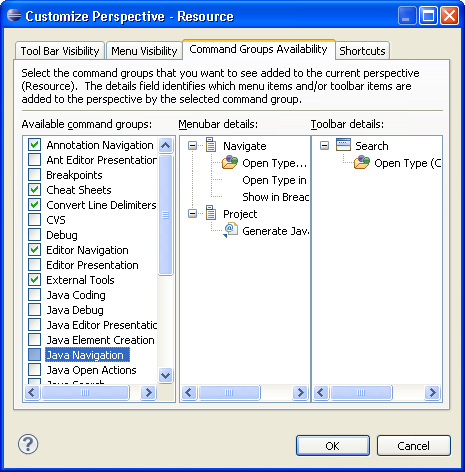
|
| Restoring deleted resources |
Select a container resource and use Restore from Local History to restore deleted files. You can restore
more than one file at one time.
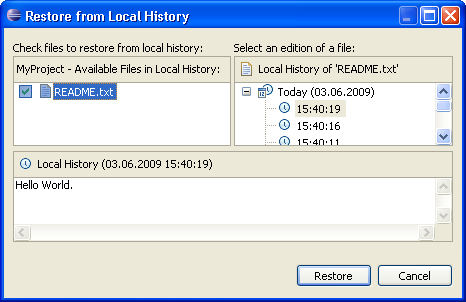
|
| Faster workspace navigation |
 Navigate > Open
Resource... (Ctrl+Shift+R) brings up a dialog that allows you to quickly locate and open an
editor on any file in the workspace. Navigate > Open
Resource... (Ctrl+Shift+R) brings up a dialog that allows you to quickly locate and open an
editor on any file in the workspace. |
| Quickly find a resource |
Use the Navigate > Go To > Resource command to quickly
find a resource. If the Go To > Resource command does not appear in your perspective, you can add it by
selecting  Window > Perspective >
Customize Perspective, then Other > Resource Navigation. Window > Perspective >
Customize Perspective, then Other > Resource Navigation. |
| Copying and moving resources |
You can drag and drop files and folders within the Project Explorer
view to move them around. Hold down the Ctrl key to make copies. |
| Importing files |
You can quickly import files and folders into your workspace by
dragging them from the file system (e.g., from a Windows Explorer window) and dropping them into the Project
Explorer view. The files and folder are always copied into the project; the originals are not affected. Copy and
paste also work. |
| Exporting files |
Dragging files and folder from the Project Explorer view to the file
system (e.g., to a Windows Explorer window) exports the files and folders. The files and folder are always
copied; workspace resources are not affected. Copy and paste also work. |
| Transfer preferences |
The preferences can be transferred from one workspace to another by exporting and importing them. In addition,
it is possible to only do this for selected categories:
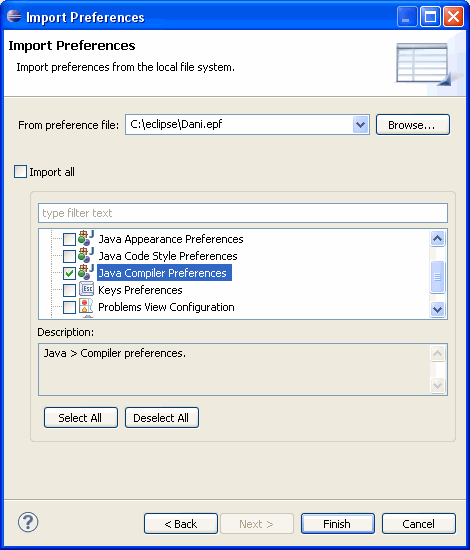
Easily accessible buttons for opening the Import/Export preferences wizard are available in the lower
left corner of the Preferences dialog. The wizards are also accessible via File >
Import.../Export... > General > Preferences.
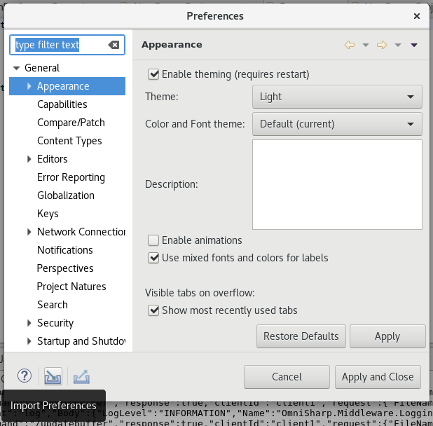
|
| Copy preferences during workspace switch |
You can copy preferences during a switch to a new or existing workspace.
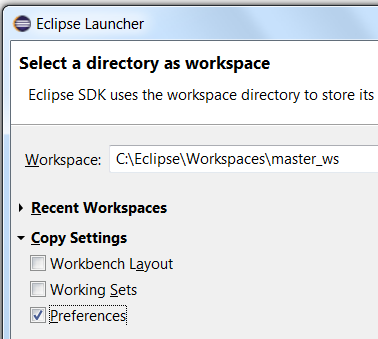
|
| Workspace project management |
Use the Project > Close Project command to manage projects
within your workspace. When a project is closed, its resources are temporarily "offline" and no longer appear in
the Workbench (they are still sitting in the local file system). Closed projects require less memory. Also, since
they are not examined during builds, closing a project can improve build times. |
| Describing your configuration |
When reporting a problem, it's often important to be able to capture
details about your particular setup. The Installation Details button on the  Help > About
Product dialog opens a dialog containing pages that describe different aspects of your
installation. The Configuration page displays a file containing various pieces of information about your
setup, including plug-in versions, preference settings, and the contents of the internal log file. You can copy
and save this information, and attach the saved file to your problem report. Help > About
Product dialog opens a dialog containing pages that describe different aspects of your
installation. The Configuration page displays a file containing various pieces of information about your
setup, including plug-in versions, preference settings, and the contents of the internal log file. You can copy
and save this information, and attach the saved file to your problem report. |
| Deleting completed tasks |
Use the Delete Completed Tasks command in the Task view context
menu to remove all completed tasks from the Tasks view. This is more convenient than individually selecting and
deleting completed tasks. |
| Viewing resource properties |
Use the Properties view ( Window > Perspective > Show View > Properties) when viewing
the properties for many resources. Using this view is faster than opening the Properties dialog for each
resource. Window > Perspective > Show View > Properties) when viewing
the properties for many resources. Using this view is faster than opening the Properties dialog for each
resource.

|
| Extra resource information |
Label decorations are a general mechanism for showing extra information
about a resource. Use the
 General > Appearance
> Label Decorations preference page to select which of the available kinds of decorations you
want to see. General > Appearance
> Label Decorations preference page to select which of the available kinds of decorations you
want to see. |
| Filtering resources |
Most views that show resources support filtering of their items. You
control which items are visible by applying filters or working sets. The commands to filter are found in the view
menu. |
| Quick fix in Tasks view |
You can use the Quick Fix command in the Tasks view to suggest
an automatic fix for the selected item. The Quick Fix command is only enabled when there is a suggested
fix. |
| Creating path variables |
When creating a linked folder or file, you can specify the target location relative to a path variable. By
using path variables, you can share projects containing linked resources without requiring team members to have
exactly the same path in the file system. You can define a path variable at the time you create a linked
resource, or via the
 General > Workspace
> Linked Resources preference page. General > Workspace
> Linked Resources preference page.
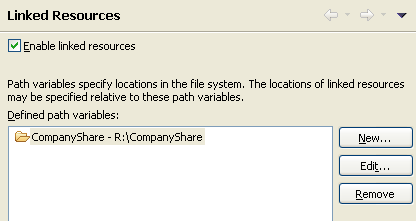
|
| Comparing zip archives with each other or with a
folder |
Select two zip archives or one archive and a folder in the resource Project Explorer view and choose
Compare With > Each Other from the view's popup menu. Any differences between the two
inputs are opened in a Compare editor. The top pane shows all the archive entries that differ. Double clicking
on an item performs a content compare in the bottom pane.
This works in any context where a file comparison is involved. So if a Synchronize operation lists an
archive in the resource tree, you can double click on it in order to drill down into changes within the
archive.
|
| Switch workspace |
Instead of shutting down eclipse and restarting with a different workspace you can instead use  File > Switch
Workspace. From here you can either open previous workspaces directly from the menu or you can
open the workspace chooser dialog to choose a new one. File > Switch
Workspace. From here you can either open previous workspaces directly from the menu or you can
open the workspace chooser dialog to choose a new one.
When you change certain preferences that require a restart to take effect (such as the
 General >
Appearance preferences), use File > Restart. General >
Appearance preferences), use File > Restart.
|
| Show workspace path |
The
 General >
Workspace preference page shows the current workspace path. In addition, you can show the path in
window title by checking the option "Show current workspace path in window title". General >
Workspace preference page shows the current workspace path. In addition, you can show the path in
window title by checking the option "Show current workspace path in window title".
The -showLocation command line argument can also be used to show the path in window title and
it overrides the preference.
|
| Disabling unused capabilities |
If there are parts of the Eclipse Platform that you never use (for instance, you don't develop Plug-ins) it's possible that you can disable them from the UI entirely. Segments of the
Workbench that may be filtered can be found in the
 General >
Capabilities preference page. By disabling capabilities you are able to hide views, perspectives,
preference pages and other assorted contributions. General >
Capabilities preference page. By disabling capabilities you are able to hide views, perspectives,
preference pages and other assorted contributions.
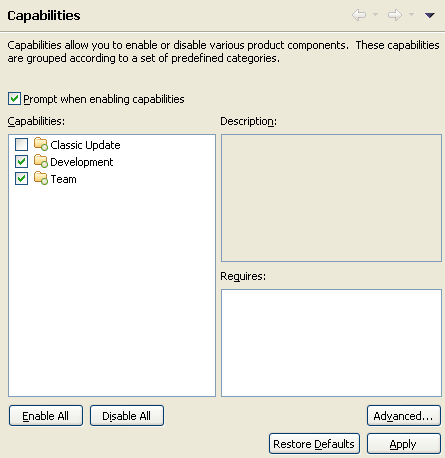
|
| Storing the encoding of derived resources separately |
Usually the encodings for all files in a project are stored in one preferences file. If you are using a version
control system and the preferences file is shared, the encodings for all resources, including derived, are
shared along with it. To store the encodings of derived resources in a separate preferences file and avoid
sharing it, go to Project > Properties > Resource and select the Store the encoding of derived
resources separately option.

|
| Debug option for resource change notifications |
In order to help troubleshooting problems with resource change listeners and to print information about which
event triggers which listener, you can use the given debug option. To get a better picture of the flow of all
workspace change events and how other plug-ins react to those changes, you can enable this debug option by
adding
org.eclipse.core.resources/debug=true
org.eclipse.core.resources/notifications=truein your .options file or using the
 General > Tracing
preference page. General > Tracing
preference page.
|
| Terminate and Relaunch from history |
You can use the Terminate and Relaunch while launching from history option on the
 Run/Debug >
Launching preference page to configure automatic termination of previous launches while launching from
history. Run/Debug >
Launching preference page to configure automatic termination of previous launches while launching from
history.
The behavior not selected on the preference page can also be activated on-demand by holding the Shift
key while launching the configuration from history.

Hint: You can still open the dialog to edit a launch configuration by holding the Ctrl key
while selecting the configuration from history.
|
| Launch multiple launch configurations sequentially |
You can create a Launch Group via the Run > Run Configurations... or Run > Debug
Configurations... dialog to launch multiple launch configurations sequentially, with configurable actions
after launching each group member:
- None: Continue launching the next member right away
- Wait until terminated: Continue launching the next member only after this member has terminated
- Delay: Delay launching the next member for a given amount of seconds.
- Wait for console output (regexp): Allows to delay further processing of launch group elements until a
certain output (matching a regular expression) appears on the console of the given group element.
- Adopt launch if already running: Allows to control the behaviour of the group when the launch
configuration referenced by the launch group element is already running (no matter who launched it). If
checked, the launch configuration will not be launched again if it is running already. The existing launch
will be adopted by the group (i.e. terminating the group will also terminate this launch). Any configured
post launch action will still be executed!
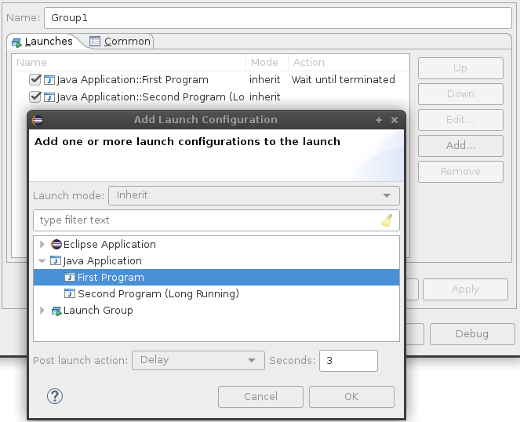
|
| Export Launch Configurations |
The Export Launch Configurations wizard can be easily accessed via the context menu on Launch
Configurations. This wizard is also available with File > Export > Run/Debug > Launch
Configurations.
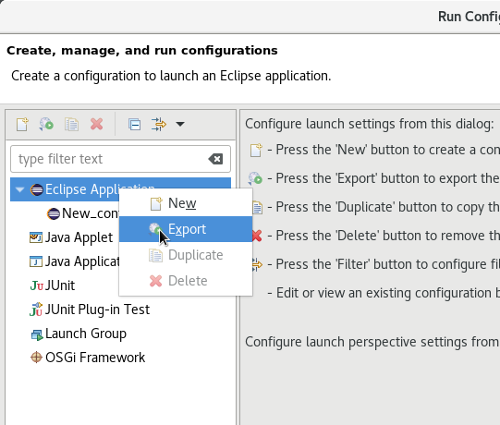
|
| Sort breakpoints by creation time |
You can use the Sort By > Creation Time option in Breakpoints view's view menu to show the
newly created breakpoints on top.

|
| Finding a string incrementally |
Use Edit > Incremental Find Next (Ctrl+J) or Edit >
Incremental Find Previous (Ctrl+Shift+J) to enter the incremental find mode, and start typing the string to
match. Matches are found incrementally as you type. The search string is shown in the status line. Press
Ctrl+J or Ctrl+Shift+J to go to the next or previous match. Press Enter or Esc to
exit incremental find mode. |
| Go to last edit location |
Navigate > Previous Edit Location (Ctrl+Q) takes you back to
the place where you last made a change. A corresponding button marked  is shown in the toolbar. If this toolbar button
does not appear in your perspective, you can add it by selecting is shown in the toolbar. If this toolbar button
does not appear in your perspective, you can add it by selecting  Window > Perspective >
Customize Perspective, then Other > Editor Navigation. Window > Perspective >
Customize Perspective, then Other > Editor Navigation. |
| Go to multiple edit locations |
Navigate > Previous Edit Location and Navigate > Next
Edit Location take you back and forward respectively in the edit locations history. |
| Shortcuts for manipulating lines |
All text editors based on the Eclipse editor framework support editing functions,
including moving lines up or down (Alt+Arrow Up and Alt+Arrow Down), copying lines
(Ctrl+Alt+Arrow Up and Ctrl+Alt+Arrow Down), inserting a new line above or below the current line
(Ctrl+Shift+Enter and Shift+Enter), and converting to lowercase or uppercase (Ctrl+Shift+Y
and Ctrl+Shift+X). |
| Quick Diff: seeing what has changed as you edit |
Quick Diff provides color-coded change indication while you are typing. It can be turned on for text editors
using either the ruler context menu, Ctrl+Shift+Q or for all new editors on the
 General > Editors >
Text Editors > Quick Diff preference page. The colors show additions, deletions, and changes to
the editor buffer as compared to a reference, for example, the contents of the file on disk or its latest remote
revision. General > Editors >
Text Editors > Quick Diff preference page. The colors show additions, deletions, and changes to
the editor buffer as compared to a reference, for example, the contents of the file on disk or its latest remote
revision.

When the mouse cursor is placed over a change in the vertical ruler, a hover displays the original content,
which can be restored using the ruler's context menu. The context menu also allows you to enable/disable Quick
Diff.
|
| Customizing the presentation of annotations |
You can customize the presentation of annotations in editors on the
 General > Editors >
Text Editors > Annotations preference page: General > Editors >
Text Editors > Annotations preference page:
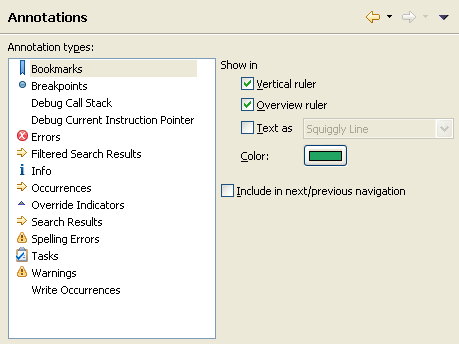
|
| Next / previous navigation |
You can use Ctrl+. and Ctrl+, to navigate to the next or
previous search match, editor error, or compare difference. These are the shortcut keys for Navigate >
Next and Navigate > Previous. |
| Line delimiter support |
You can set the line delimiter that is used when creating new text files. You can provide a single setting for
the entire workspace, using the
 General >
Workspace preferences, or for a given project. General >
Workspace preferences, or for a given project.
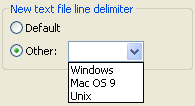
Note: Changing those settings does not convert existing files. To convert the line
delimiters in a project, folder or file use File > Convert Line Delimiters To >.
|
| Word completion |
In any text editor you can complete a prefix to a word occurring in all
currently open editors or buffers. The default key binding for word completion is Alt+/. (Ctrl+. on
the Mac). |
| Open untitled files |
A text editor can be opened without creating a file first: select
File > New > Untitled Text File. |
| Commands to zoom in text editors |
In text editors, you can use Zoom In (Ctrl++ or Ctrl+=) and Zoom Out
(Ctrl+-) commands to increase and decrease the font size.
Like a change in the
 General > Appearance >
Colors and Fonts preference page, the commands persistently change the font size in all editors of the
same type. If the editor type's font is configured to use a default font, then that default font will be
zoomed. General > Appearance >
Colors and Fonts preference page, the commands persistently change the font size in all editors of the
same type. If the editor type's font is configured to use a default font, then that default font will be
zoomed.
|
| Pinch to zoom in text editors |
To temporarily zoom the editor font in text editors, use a "pinch" gesture on a touchpad. Put two
fingers on the touchpad and move them apart or together.
To reset the original font size, rotate two fingers by at least 45o, or close and reopen the
editor (Navigate > Back).
Those gestures only affect the current editor. Changes are neither propagated to other editors nor
persisted.
Note: SWT currently only supports these gestures on OS X and on Windows systems that use the native
multi-touch support. Touchpads that emulate mouse move/scroll events don't support gestures. Gesture support on
GTK is not implemented yet.
|
| Browser Editor can toggle auto-refresh |
The Browser Editor contains a drop down option for enabling auto-refresh for local pages. When enabled,
the Browser Editor will automatically refresh if the opened file is edited and saved.
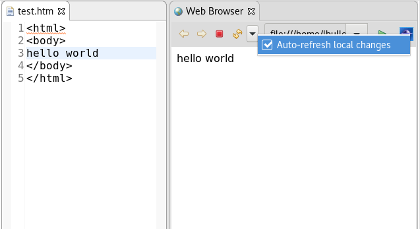
|
| Show problem markers inline |
You can see error, warning, and info problem markers inline in text editors supporting code minings by setting
the Show Code Minings for Annotations option on General > Editors > Text Editors preference
page.

|


General >
Appearance preferences page.










General >
Keys preference page.


General > Appearance
preferences page.
 indicates a valid spot to
drop.
indicates a valid spot to
drop.











General >
Appearance preferences), use File > Restart.











